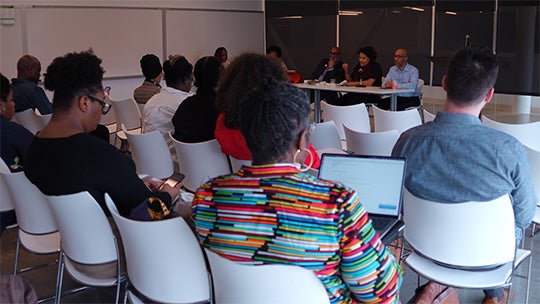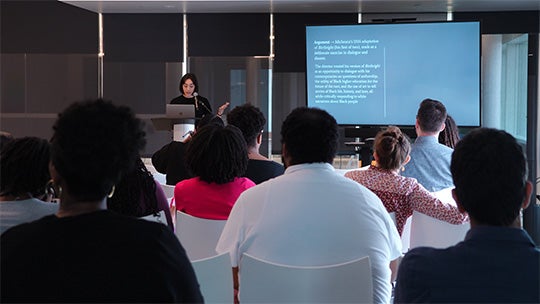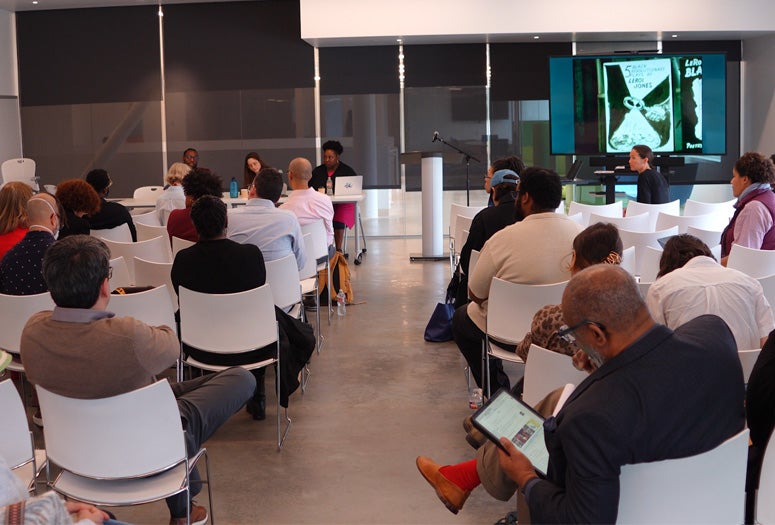The rich interplay between African American literature and the other arts took center stage at a two-day symposium at Rice University March 7-8 where scholars, poets and artists explored the aesthetic, cultural and political dimensions of Black creative expression. The event, structured around panel discussions, roundtables and poetry readings, provided a platform for academics and artists to present works in progress and engage in critical dialogue about artistic networks, activism and institutional collaborations.
“The impetus for this symposium is linked to a special issue that I’m co-editing with Brittney Edmonds from the University of Wisconsin for the journal African American Review,” said Hayley O’Malley, assistant professor of art history at Rice. “When we were putting together the call for this special issue, we really reflected on the ways in which the best special issues, the best edited collections, are those in which the contributors are in genuine dialogue with each other. The way to do that is to create a space for folks to talk to each other.”

The symposium opened with a panel on artmaking, activism and experimentation featuring discussions on William Wells Brown’s use of panorama, Amiri Baraka’s political aesthetics and Faith Ringgold’s literary contributions. Julius Fleming Jr., associate professor of English at Washington University in St. Louis, examined Ringgold’s fusion of visual and literary forms, reflecting on the significance of bringing new, in-progress research to a collaborative space.
“Through presenting, I was able to workshop very new work,” Fleming said. “So it’s good to kind of be in community with colleagues at various points in the profession to get some critical feedback for that work that will help it to be better, but also just to get a sense of some of the new ideas that are percolating among scholars in the field and to sort of be on the forefront of that through a symposium like this.”
Another panel examining the legacies and afterlives of Black modernists drew connections between literature and visual art. Leslie Wingard Cunningham, professor of English and Africana studies and associate provost for faculty development at Washington and Lee University, discussed the relationship between Zora Neale Hurston’s short story “Sweat” and the iron-and-ironing-board visual art of New Jersey artist Willie Cole.
“I believe the two texts are very well connected and demonstrate that the stories of Black culture in the United States are a complex tapestry woven from so many different experiences,” Wingard Cunningham said.
The symposium also foregrounded the contemporary state of Black literary and cultural studies in two roundtables that featured scholars from across the country. The discussions underscored the challenges facing the humanities and the field of African American studies, particularly in the current political climate.
“The humanities in some ways are under attack,” Fleming said. “The ability to convene, to think about these issues as real critical ideas, real critical histories and traditions, is so important. Through these conversations, our field becomes better.”
Later discussions centered on the connections between literature and film. In a panel on Black film cultures, O’Malley explored the ways Black women writers have reimagined filmmaking in the 20th century, demonstrating how literature has served as both a reflection and a catalyst for cinematic innovation. The panel, which also included presentations on Oscar Micheaux and the power of Black cultural production, highlighted how literary figures have shaped and been shaped by visual storytelling traditions.

Throughout the symposium, poetry readings provided an additional dimension to the exploration of artistic cross-pollination with established poets such as Evie Shockley, A. Van Jordan, Tonya Foster, Herman Beavers and Douglas Kearney sharing their work. These readings underscored the event’s broader theme of fluidity between art forms, echoing Toni Morrison’s call to recognize the “resonances, alignments, the connections” that define African American artistic traditions.
Beyond the scholarly discussions, the symposium fostered meaningful engagement between faculty, students and the broader Houston community.
“I think it’s very important at this time because students can see themselves in the different professors that are on the panels,” Wingard Cunningham said. “I’ve noticed in the audience that there are people here that are of all different ages and backgrounds, and they’re all engaging in the Q&A after the panelists speak.”
The symposium also demonstrated Rice’s commitment to sustaining and advancing Black intellectual traditions.
“It says a lot about Rice that they’ve invested in a symposium like this,” Fleming said. “I think that it could model for other institutions the type of work that we can do to keep these traditions alive, these intellectual traditions alive.”
“Rice is known for its excellence in lots of fields but has traditionally been associated with STEM fields,” said O’Malley. “This symposium is part of an effort to show the vibrant and vital humanities and arts work that’s happening on campus.”
The event was made possible through the support of numerous Rice departments and research centers, including the Center for African and African American Studies; the Center for the Study of Women, Gender and Sexuality; the Creative Ventures Funds; the departments of art, anthropology, art history, English and modern and classical literatures and cultures; the Humanities Research Center; the Moody Center for the Arts; and the Office of the Dean of Humanities.

